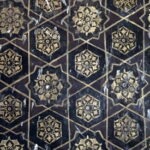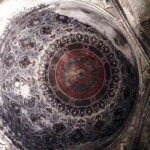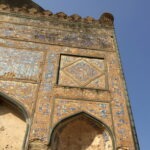Whispering monuments and roaring jets
So you’ve seen the fort – what else does Bidar have to offer? Bidar town is, to be honest, not a great place to hang out in: it’s dusty, scruffy and noisy. It almost completely turns its back on its intriguing history and rich heritage – no wonder it’s called the “city of whispering monuments”. This is a great shame, because it certainly has sights that are worth crowing about – and especially worth taking more care of! Bidar Fort is the highlight and the main reason for visiting. So, you’ve seen the fort – what else does Bidar have to offer?

Quite a bit, actually. Take the ancient-looking domes we spotted from our hotel’s rooftop restaurant (not as romantic as it sounds… see later on). No mention in the guide book, nothing we could see on Trip Advisor, nothing on the map. So one afternoon, we simply headed out of the hotel in their direction — they stood head and shoulders above everything else around us. The walk took us through an overgrown park; I seriously would not have crossed on my own – a bit creepy.
Intricate decorations
It was worth it. The domes top off mausoleums built to be the final resting places of two Bidar kings, the dynasty that replaced the Bahmanis. One was for the founder of the new Barid Shah dynasty, Qasim, but the most stunning of the pair belongs to his grandson, Ali Barid Shah, who enjoyed a long, if warring, reign from 1542-1580. He had it built three years before the end of his rule, leaving spaces inside the pavilion for his wives, while empty tombs outside awaited members of his harem. The 70-foot-high mausoleum is essentially Islamic in silhouette, yet its elaborate decoration is very much Hindu in appearance. Intricately carved floral motifs appear on the archways, but the crowning glory are the mosaic tiles adorned with texts from the Quran.
Given the lack of care shown towards these tombs — no security of any description — it is quite amazing that these beautiful tiles are still on display. The structure is set on a huge plinth and open on all four sides, providing a shady retreat for locals. We chatted with one young man who was an engineering student — it seems India is full of young people studying engineering, which bodes well for the future.
And what would India be without its tombs? The Taj Mahal is the most famous, obviously, but the country is littered with examples that may not be as imposing as Shah Jahan’s tribute to his wife Mumtaz, but are just as beautiful. Bidar has yet more — the Bahmani necropolis lies a few kilometres east of the town at Ashtur. The most intriguing is the tomb whose dome was shattered by lightning — it looks like a cut-away drawing in one of my architectural history books! It belonged to Humayan Shah.
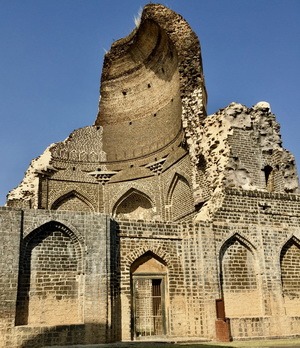
The interior of the tomb of Ahmad Shah I Wali reflects his patronage of the arts, and it seems likely that Persian craftsmen were involved here. Persian-style paintings adorn the walls and dome, along with Sufi calligraphy. The mausoleum of Allauddin Shah II is another highlight — patches of blue tilework are still to be seen on the exterior, while the polished black stone trims of the recesses are decorated with rope- and key-patterned motifs.
Back in town, the Mahmud Gawan Madrasa is worth a look, even though you can only view the exterior. A madrasa is an Islamic school or college, and this one was built in 1472 (around the same time as St Catharine’s College, Cambridge). It was founded by prime minister Mahmud Gawan, whom I mentioned in a previous blog. Despite all the good work he did for the sultanate the poor chap was eventually executed, probably because, as a Persian, he was considered an outsider. The gate is locked, so you can’t get inside, but you can walk around the perimeter platform. It’s worth it to peer up at the yellow, blue, green and white tilework around the upper part of the building and minaret.
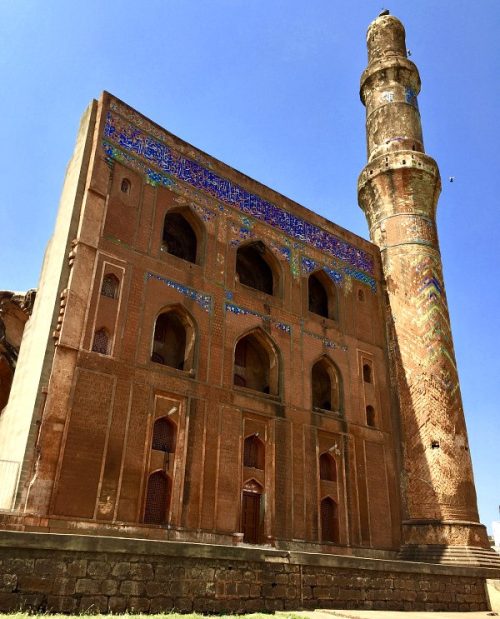
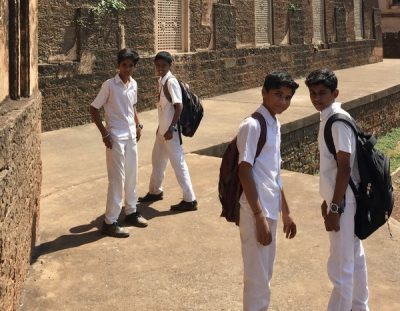
Bidar is a long way from the Sikh heartland of the Punjab, so it is surprising to come across the Guru Nanak Jhira Sahib, a shrine to the founder of the Sikh religion. This huge wedding-cake white building glistens in the sunshine. It was built in the year India gained its independence, on the site of a spring; tradition has it that Guru Nanak discovered the source on his tour of southern India in the early 16th century. Anyone is free to go into the shrine — having first deposited their shoes at the entrance — and take part in the blessing ceremony.

What else does Bidar have to offer?
Final thoughts on Bidar
We chose the Hotel Mayura using Lonely Planet and Trip Adviser. One of the key criteria for us in picking a mid-range Indian hotel in a non-touristy town is to look for somewhere that not only has a restaurant, but a bar too. No bar and it’s unlikely you’ll get served beer with your meal — hey, we’re on holiday, we want a cold beer or two or three at the end of the day! — and you may not even get it on room service, though room boys (more to follow later) can usually be persuaded to get a few bottles in, on payment of a reasonable tip. The Mayura boasted a bar, as did the Hotel Mayura Barid Shahi, so it was a toss up between the two. The latter sounded appealing with its”garden bar-restaurant”, though rooms were described in LP as “simple, institutional” and the hotel “needed maintenance”. After reading the reviews, we went with the former. In fact, we did have lunch in the Mayura Barid Shah’s garden, and the food and ambience were good. We asked at the front desk about rooms: the surly receptionist could have done with some maintenance himself — in the polite, friendly and helpful department, so we were glad we hadn’t picked it.

The Mayura was down a grubby, unpaved side street, but the receptionist was helpful, as was the “room boy”, who, of course, wasn’t a boy at all. Room boys are important in older, traditional Indian hotels — they’ll get you extra bedding, a flask of drinking water, more toilet paper, a big bucket of piping hot water for a mandi-style shower in those establishments that restrict timing of hot water showers. Our room was basic, but reasonably big, though the bathroom was exceedingly shabby. The day we arrived, the place was packed with businessmen attending a sales conference, milling around the corridors which echoed with good-natured joshing and some horse play. The “whisky party” was taking place in the room next to ours (door always open). There must have been over 30 guys in there, sprawled on the beds around a table full of whisky, water and coke bottles. We were a source of curiosity to them, and any time our room door was left open (the room boy was coming and going a fair bit) inquisitive heads appeared round the doorway.
The restaurant/bar comprised a series of dimly lit rooms on the ground floor, with an attached garden area. This is pretty typical for Indian hotel bars — they are all as dark as bat caves for some reason. We didn’t fancy the coal hole for dinner (though we’d had a beer there earlier), and the garden was fully occupied, so we were directed to the top floor. This large “function room” didn’t actually afford views of the bright lights of Bidar… ahem. The curtains were closed and lighting was provided by the type of red lightbulbs found at student parties circa 1972. But it was spacious, and using the light from our phones we were just about able to read the menu. The food was pretty good — chicken tikka, dal, some other veggie dish. And a few bottles of cold Kingfisher premium.
“All the other fellows, they will get very drunk.”
On our last night we decided to book a table in the garden… the manager was very dubious. Bar/restaurants of the bat-cave type in India are NOT where women are seen; they are very much for guys to get together with their drinking buddies. “All the other fellows, they will get very drunk…” he said, obviously concerned for my welfare. “Oh, we’re British… we don’t mind drunk,” I replied. And it was fine… plenty of drinking going on but nothing untoward!
Just one more thing to note. Those monuments certainly whisper in comparison to the roar and boom of jet engines care of the Indian Air Force. The city is home to one of the country’s top military jet training schools, so be prepared for ear-splitting sounds from breakfast time to mid-afternoon, every day except Sunday.
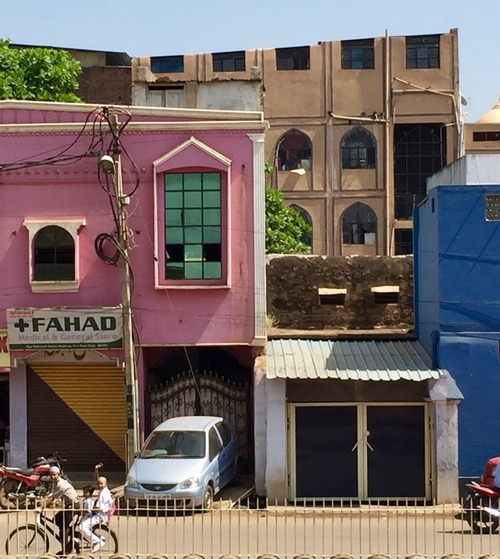
This is weird...
Take a look at the building in the background. Yes - it looks as if someone has taken a giant pair of scissors and cut the top off at an angle! I took the photo because I liked the blue and pink buildings and the boys on the bike. It wasn't until later I noticed the background, so I've recropped it to make the truncated windows more of a focus.

